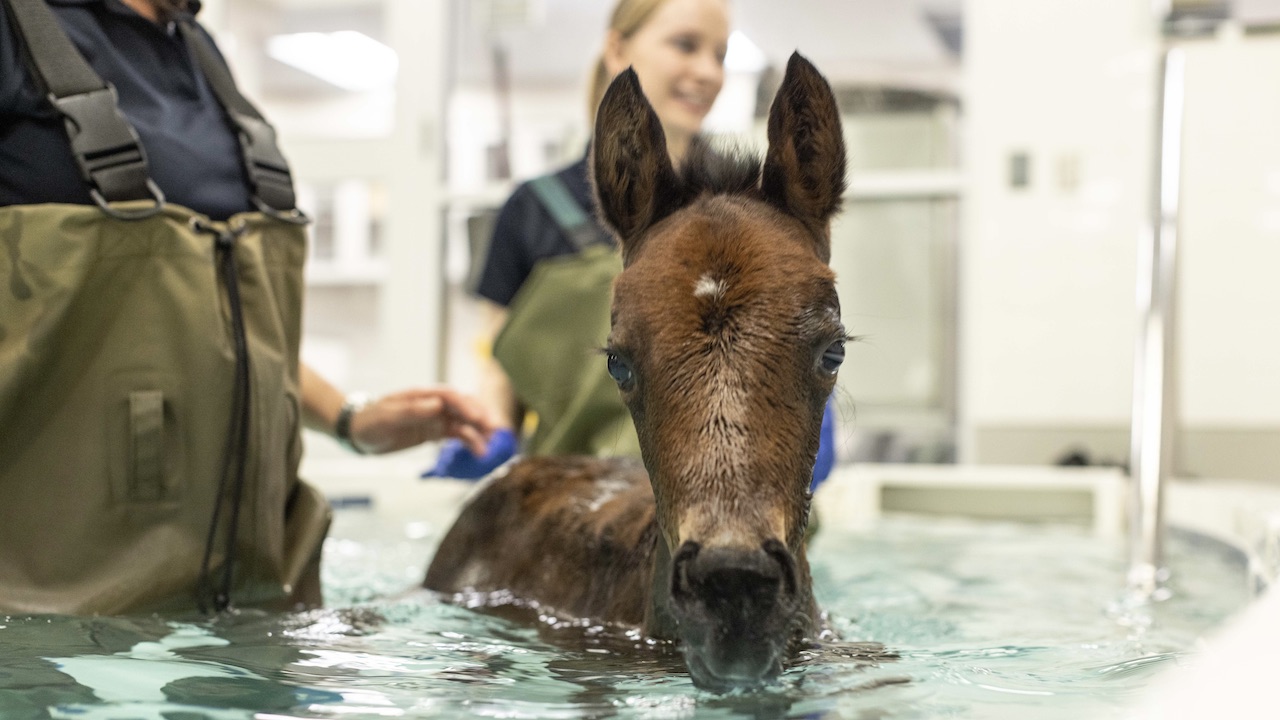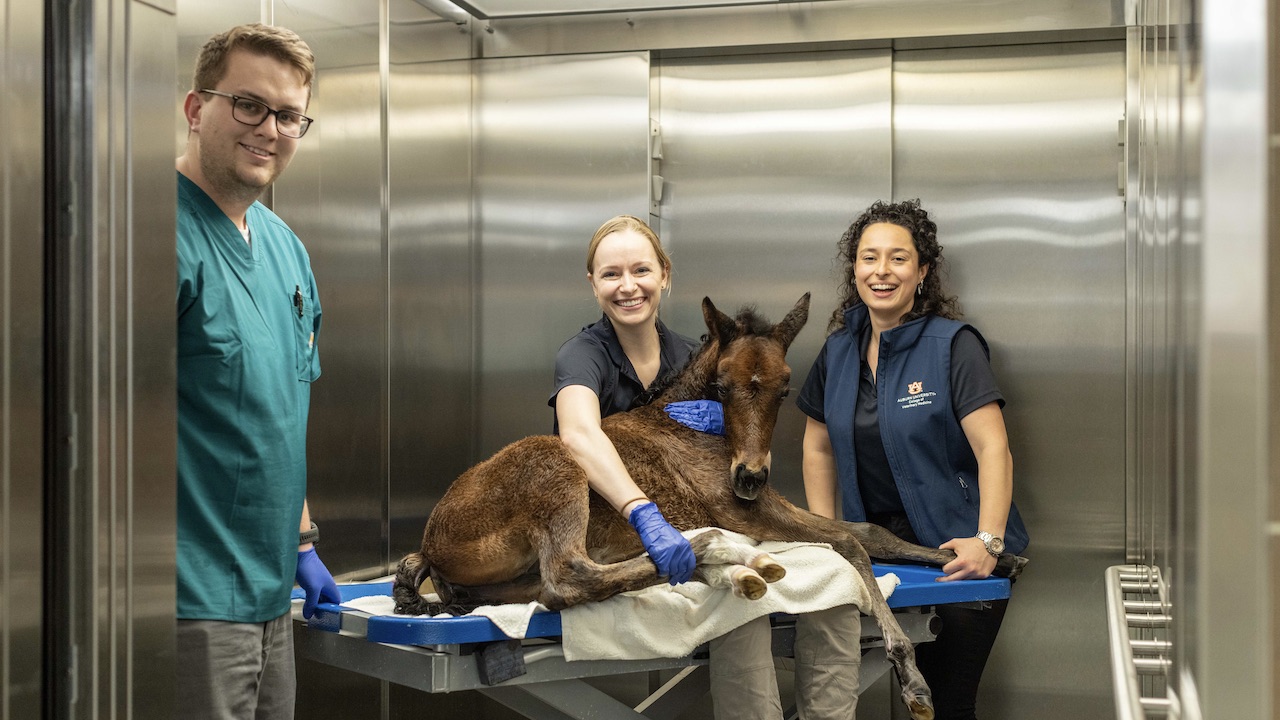content body
What happens when you think creatively? What happens when small animal and large animal teaching hospitals collaborate? Creative care solutions.
Just ask Tink, a young foal who had a rough start but is now “full of life.”
This is a story about how the small and large animal teaching hospitals at Auburn’s College of Veterinary Medicine worked together to solve a difficult problem — offering Auburn veterinary students a unique hands-on training experience and Tink a second chance at a quality life.
Now Tink has a better future, and Auburn clinicians, residents, interns and students are better prepared to tackle tough clinical challenges.
The good news first
Unlike most stories, let’s start with the ending: Tink is in good health today.
“Tink is very full of life and full of herself. Gritty is what I call it. Auburn University went the extra mile and gave her the best possible care,” said Tink’s owner, Mary Bullard. “They thought outside the box to provide aquatic therapy. That was a huge milestone to improve her quality of life.”
Now, let’s go back to the beginning.

Foal “Tink” in resistance swimming pool in Auburn’s Bailey Small Animal Teaching Hospital.
Tink’s arrival at Auburn
This past fall, a very sick Tink arrived at Auburn’s John Thomas Vaughan Large Animal Teaching Hospital.
She was born prematurely to a mother who had placentitis and who rejected her. Foals must stand within one hour of birth and nurse within two hours, and Tink was unable to do either.
Dr. Erin Groover was involved in Tink’s case from the beginning; she is a clinical professor in equine internal medicine. She worked with Auburn’s veterinary students on Tink’s day-to-day medical care to get her stabilized.
“That first week, students were hugely involved in the success of her living,” said Groover.
Dr. Kara Lascola, associate professor in equine internal medicine, assumed Tink’s care to focus on residual orthopedic issues once medical systemic concerns were under control.
Since Tink was born prematurely, her joints did not finish maturing.
“If we did not manage, it would lead to long-standing orthopedic problems, like not being athletic or a poor quality of life,” said Lascola. “We saw some improvements in Tink, but some things remained concerning even though Tink was stable, happy and bright.”
The foal could not stand on her legs. Lascola needed to balance this inability with a way to strengthen the legs.

Collaborating on creative care
This is when Dr. Lindsey Boone, associate professor of equine surgery and sports medicine, enters the story. Boone is involved in large animal sports medicine and had previously collaborated with licensed veterinary technician Liz Hodson in the Wilford and Kate Bailey Small Animal Teaching Hospital on physical rehabilitation.
Boone was aware that the dog-sized therapy pool could accommodate goats, but a foal? Groover, Lascola and Boone considered whether Tink could work in the physical therapy pool with Hodson. And a creative solution was born.
The brainstorming resulted in seven underwater therapy sessions for Tink in the small animal hospital, delivering definite improvement in her strength and alignment — plus a whole lot of attention from students and faculty.
“Tink was very popular with the students,” said Lascola. “Lots of students were interested in a foal swimming in the small animal hospital.”
In fact, almost every equine student observed the first day Tink was in the pool.
Tink benefits from water therapy
Water therapy enables non-weight bearing exercises, which can help severe joint issues and arthritis while providing cardiovascular exercise. However, Tink needed to bear some weight, so Hodson conducted partial weight-bearing exercises, which allowed her joints to be put through limited stresses.
“Tink loved being in the water right from the start,” said Hodson. “She was food motivated, so we had a little pan of milk, which kept her from drinking the water and kept her moving in the water.”
Hodson and a resident spent every session with Tink, using the resistance of water to help the foal activate her small and large muscle groups; this encouraged micromovements, which worked joints in all ranges.
Students assigned to the case helped transport Tink to the small animal facility — no easy feat — and maintain her daily care. For transport, students had to put Tink on a gurney, load the gurney in an elevator and support Tink’s entry into the pool.
A new tool for large animal care
Tink’s providers agree taking a large animal into a small animal space is a unique situation.
“It’s a new thing that I would not have thought of before,” said Groover. “It didn’t occur to me to put the foal in the water…but I would do that in a second now. This adds another tool I would use.”
Groover adds that the ultimate benefit was for the students.
“This was a really sick foal. More than once, euthanasia was on the table. But this shows students, look what we were able to do to get this foal out the door,” said Groover. “It is a good thing for students to see you can be creative.”
Be a collaborative problem solver. Discover the College of Veterinary Medicine.
Learn More







